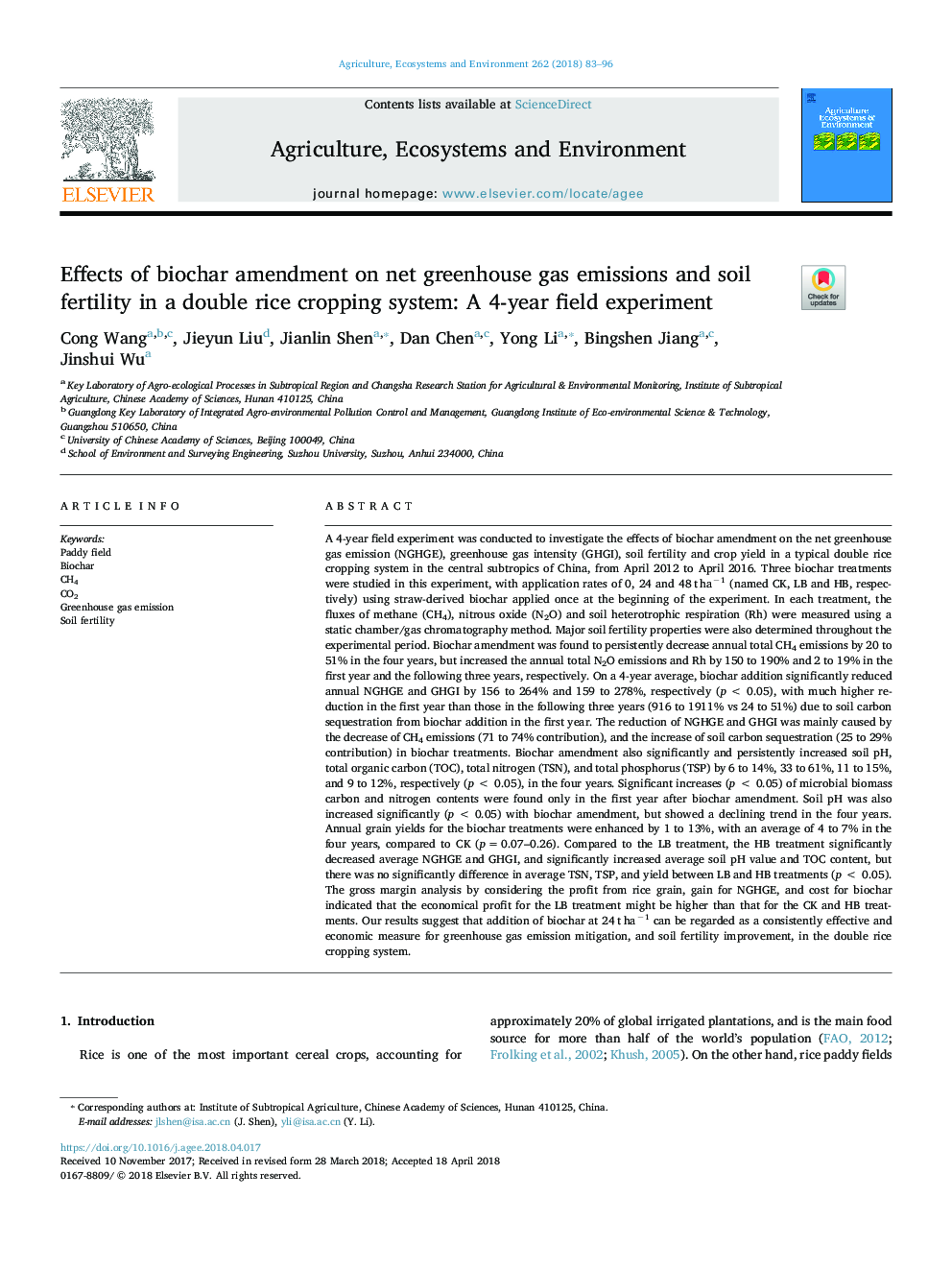| کد مقاله | کد نشریه | سال انتشار | مقاله انگلیسی | نسخه تمام متن |
|---|---|---|---|---|
| 8487050 | 1551990 | 2018 | 14 صفحه PDF | دانلود رایگان |
عنوان انگلیسی مقاله ISI
Effects of biochar amendment on net greenhouse gas emissions and soil fertility in a double rice cropping system: A 4-year field experiment
ترجمه فارسی عنوان
اثر تغییرات زیست محیطی بر انتشار خالص گازهای گلخانه ای و باروری خاک در یک سیستم برداشت محصول دو بره: یک دوره 4 ساله میدانی
دانلود مقاله + سفارش ترجمه
دانلود مقاله ISI انگلیسی
رایگان برای ایرانیان
کلمات کلیدی
موضوعات مرتبط
علوم زیستی و بیوفناوری
علوم کشاورزی و بیولوژیک
علوم زراعت و اصلاح نباتات
چکیده انگلیسی
A 4-year field experiment was conducted to investigate the effects of biochar amendment on the net greenhouse gas emission (NGHGE), greenhouse gas intensity (GHGI), soil fertility and crop yield in a typical double rice cropping system in the central subtropics of China, from April 2012 to April 2016. Three biochar treatments were studied in this experiment, with application rates of 0, 24 and 48â¯tâ¯haâ1 (named CK, LB and HB, respectively) using straw-derived biochar applied once at the beginning of the experiment. In each treatment, the fluxes of methane (CH4), nitrous oxide (N2O) and soil heterotrophic respiration (Rh) were measured using a static chamber/gas chromatography method. Major soil fertility properties were also determined throughout the experimental period. Biochar amendment was found to persistently decrease annual total CH4 emissions by 20 to 51% in the four years, but increased the annual total N2O emissions and Rh by 150 to 190% and 2 to 19% in the first year and the following three years, respectively. On a 4-year average, biochar addition significantly reduced annual NGHGE and GHGI by 156 to 264% and 159 to 278%, respectively (pâ¯<â¯0.05), with much higher reduction in the first year than those in the following three years (916 to 1911% vs 24 to 51%) due to soil carbon sequestration from biochar addition in the first year. The reduction of NGHGE and GHGI was mainly caused by the decrease of CH4 emissions (71 to 74% contribution), and the increase of soil carbon sequestration (25 to 29% contribution) in biochar treatments. Biochar amendment also significantly and persistently increased soil pH, total organic carbon (TOC), total nitrogen (TSN), and total phosphorus (TSP) by 6 to 14%, 33 to 61%, 11 to 15%, and 9 to 12%, respectively (pâ¯<â¯0.05), in the four years. Significant increases (pâ¯<â¯0.05) of microbial biomass carbon and nitrogen contents were found only in the first year after biochar amendment. Soil pH was also increased significantly (pâ¯<â¯0.05) with biochar amendment, but showed a declining trend in the four years. Annual grain yields for the biochar treatments were enhanced by 1 to 13%, with an average of 4 to 7% in the four years, compared to CK (pâ¯=â¯0.07-0.26). Compared to the LB treatment, the HB treatment significantly decreased average NGHGE and GHGI, and significantly increased average soil pH value and TOC content, but there was no significantly difference in average TSN, TSP, and yield between LB and HB treatments (pâ¯<â¯0.05). The gross margin analysis by considering the profit from rice grain, gain for NGHGE, and cost for biochar indicated that the economical profit for the LB treatment might be higher than that for the CK and HB treatments. Our results suggest that addition of biochar at 24â¯tâ¯haâ1 can be regarded as a consistently effective and economic measure for greenhouse gas emission mitigation, and soil fertility improvement, in the double rice cropping system.
ناشر
Database: Elsevier - ScienceDirect (ساینس دایرکت)
Journal: Agriculture, Ecosystems & Environment - Volume 262, 15 July 2018, Pages 83-96
Journal: Agriculture, Ecosystems & Environment - Volume 262, 15 July 2018, Pages 83-96
نویسندگان
Cong Wang, Jieyun Liu, Jianlin Shen, Dan Chen, Yong Li, Bingshen Jiang, Jinshui Wu,
